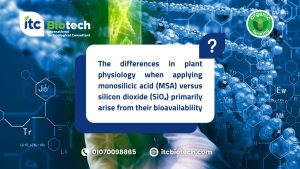
The differences in plant physiology when applying monosilicic acid (MSA) versus silicon dioxide (SiO₂) primarily arise from their bioavailability, absorption mechanisms, and systemic effects on plants. Here’s a breakdown:
1. Bioavailability
• Monosilicic Acid (MSA):
- MSA provides silicon in its most bioavailable form: H₄SiO₄ (soluble silica).
- Plants can directly absorb monosilicic acid through their roots or leaves without further conversion.
- This allows for immediate uptake and faster systemic effects.
• Silicon Dioxide (SiO₂):
- SiO₂ is an insoluble and crystalline form of silicon.
- For plants to utilize SiO₂, it must undergo slow dissolution into H₄SiO₄ in the soil or solution.
- This process depends on environmental factors such as soil pH, moisture, and microbial activity, leading to delayed availability.
2. Absorption and Transport
• MSA:
- Rapidly absorbed and transported through the plant’s xylem.
- Promotes uniform silicon distribution in plant tissues, enhancing systemic effects.
• SiO₂:
- Limited immediate absorption because it must first dissolve into H₄SiO₄, which occurs at a slow rate.
- Often remains localized in the soil and is less efficient in supplying silicon to plants within a short timeframe.
3. Effects on Plant Physiology
• MSA:
- Stress Resistance: Faster integration into cell walls as silica (SiO₂), enhancing structural strength and resilience against pests, diseases, drought, and salinity.
- Growth Promotion: More direct influence on stress-related signaling pathways, improving photosynthesis and stress tolerance.
- Nutrient Interactions: MSA does not interfere with other nutrients, ensuring optimal uptake.
• SiO₂:
- Long-Term Benefits: Acts as a slow-release source of silicon, beneficial for maintaining soil silicon levels over time.
- Localized Effects: Contributes to improving soil structure and microbial activity but provides less immediate physiological benefits to the plant.
4. Practical Applications
• MSA:
- Best for crops requiring rapid stress mitigation, such as during drought, salinity, or pest attacks.
- Effective in hydroponics, foliar sprays, or soil applications for immediate silicon supplementation.
• SiO₂:
- More suitable as a long-term soil amendment to improve soil silicon levels over time.
- Commonly used in agricultural practices aimed at maintaining soil health rather than achieving immediate physiological benefits.
Summary
- MSA: Highly bioavailable, immediate effects, rapid absorption, and suitable for addressing acute stress or nutrient deficiencies in plants.
- SiO₂: Slow-release source, less bioavailable, and beneficial for long-term soil management rather than immediate plant uptake.
Choosing between them depends on the crop’s specific needs, environmental conditions, and the desired speed of physiological effects.
Mr. Ihab Sharaf
CEO

